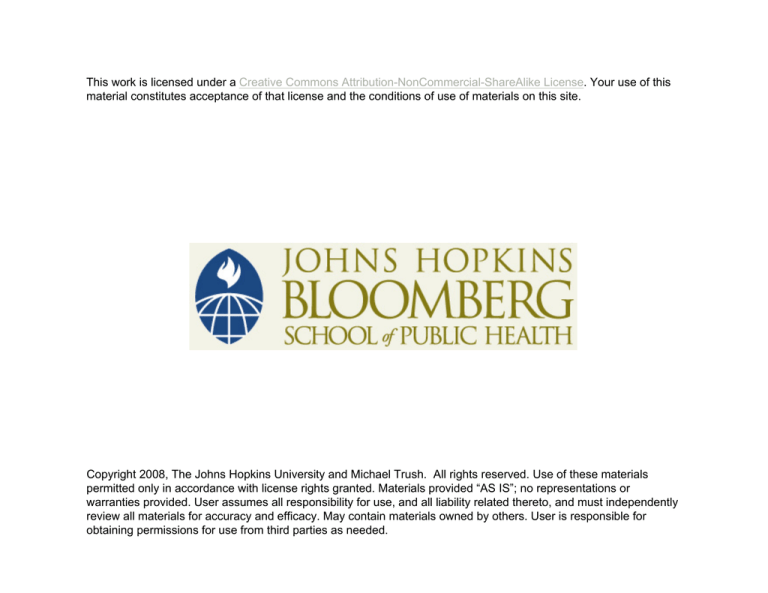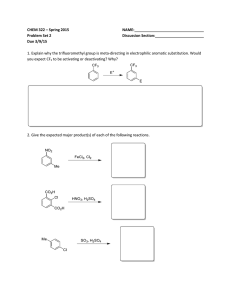
This work is licensed under a Creative Commons Attribution-NonCommercial-ShareAlike License. Your use of this
material constitutes acceptance of that license and the conditions of use of materials on this site.
Copyright 2008, The Johns Hopkins University and Michael Trush. All rights reserved. Use of these materials
permitted only in accordance with license rights granted. Materials provided “AS IS”; no representations or
warranties provided. User assumes all responsibility for use, and all liability related thereto, and must independently
review all materials for accuracy and efficacy. May contain materials owned by others. User is responsible for
obtaining permissions for use from third parties as needed.
Air Toxicants
Michael A. Trush, PhD
Johns Hopkins University
OZONE :A Criteria Air Pollutant
Section A :Sources and
Pulmonary Responses
to Air Toxicants
Air Pollutants
Heat from the sun reacts with chemicals from the
air (nitrogen oxides, particulate matter) to form
photo-chemical smog
Layer of warm air traps smog
Population exposed to high levels of
– Particulate matter
– Sulfuric Acid and sulfate and nitrate salts
– Carbon mononxide
– Lead
A Smog Wave Is Born
How Baltimore experienced six straight
days of unhealthful smog
Winds from the west bring pollutants from as far
away as Pittsburgh and the Ohio Valley. A high
pressure ridge settles just to the west, keeping
clouds from forming
Hydrocarbons and nitrogen oxides from cars,
smokestacks, and other sources mix solar-heated
air with pollutants from the west. The sun’s rays
stimulate a chemical reaction, forming ozone.
The easterly breeze blowing off the Chesapeake
Bay acts as a “wall,” holding pollutants alongside
the Interstate 95 corridor, allowing smog to build
up.
Source: University of Maryland; Maryland Dept of the Environment
Generation of Ozone via the Photolytic
Cycle
Photolytic Cycle
ENGINE
NO2
UV Radiation
from sunlight
NO + O
O2
O3
O2
Continued
Photolytic Cycle
NO2
O2
+
HC
UV Radiation
from sunlight
NO + O
HCO2
Continued
Photolytic Cycle
ENGINE
NO2
O2
+
HC
UV Radiation
from sunlight
NO + O
HCO2
O2
O3
O2
EPA Color Coding for Ozone
Section B
Responses to Ozone Exposure
Pulmonary Responses
to Toxicants
Local irritation, which results in bronchial
constriction and edema; secondary
infection (bronchitis) frequently compounds
the damage
Damage to the cells of the airway which
results in necrosis
Continued
Pulmonary Responses
to Toxicants
Fibrosis (excessive deposition of the
extracellular matrix) and emphysema (loss
of airways)
Airway constriction through allergic
responses (asthma)
Lung cancer ( ozone may be a tumor
promoter)
Acute Effects of Ozone Exposure
ACUTE EFFECTS OF OZONE EXPOSURE
1-3 H ACUTE
OZONE EXPOSURE
EXERCISE PERFORMANCE DECLINE
>10% DROP IN MEAN FEV1
BACKGROUND OZONE LEVELS
INCREASED SYMPTOMS
>10% DROP IN INDIVIDUAL FEV1
.01
.02
.04
.08
.10 .12
.20 .25
.50
>10% DROP IN INDIVIDUAL FEV1
4-8 H ACUTE
OZONE EXPOSURE
INCREASED SYMPTOMS
>10% DROP IN IMEAN FEV1
LUNG CELLULAR INJURY
IN ANIMALS
1.0
Section C: Toxicokinetics and
Toxicodynamics of Ozone
Where Ozone Goes in the Body When
Inhaled
Excess Oxygen-18 in Tissues of Animals Exposed to 1.0ppm
18
O3
Experiment Animal
Tissue
n
Tissue
Oxygen,
Percent of
Dry Weight
18O Enrichment
18
μmoles O/mole
Total Oxygen
1
Mouse
Lung
5
19.3 ± 0.5
14.8 ± 7.8
2
Rat
Lung
Trachea
Nasopharynx
Blood
5
4
4
4
18.6 ± 1.8
21.3 ± 1.2
19.5 ± 2.3
22.3 ± 0.3
6.6 ± 6.4
12.4 ± 8.9
7.3 ± 1.5
-1.1 ± 0.0
3
Rabbit
Lung
Alveolar
Macrophage
Lung Surfactant
Pellet
4
2
19.9 ± 0.1
14.6 ± 0.4
15.6 ± 3.5
45.2 ± 3.0
2
10.1 ± 0.8
55.0 ± 6.5
Schematic Representation
Ozone Reaction with Monoenoic Fatty Acid
-
O
O
O
O3
R′CH = CHR
R’C
H
O
O
CR
H
R′CH = CHR + + CR
H
HO
O
H2O
CR
HO
RCOOH + H2O
RCHO + H2O2
Schematic Representation
Ozone Reaction with Polyenoic Fatty Acid
O3
H2O
R′CH = CH-CH2-CH = CHR
R′CHO(COOH)
RCHO(COOH)
CHO(COOH)
CH2
CHO(COOH)
+ H2O2
Schematic Representation
Ozone Reaction with Membrane Proteins
Infectivity Model
PERCENT MORTALITY
(DIFFERENCE FROM CONTROL)
Effect of a Three-Hour Exposure to Various
Concentrations of O3 on Mice Challenged
with Aerosols of Streptococcus
80
60
40
20
0
0
196 (0.1)
392 (0.2)
588 (0.3)
686.5
785 (0.4)
981 (0.5)
O3, μg/m3 (ppm)
1178 (0.6)
1374 (0.7)
1472
1570 (0.8)
24
FOLD INCREASE (OZONE/AIR)
11
10
9
8
7
6
5
4
3
2
1
*
Acid
Phosphatase
*
*
Acid
Phosphatase
B-Glucuronidase
Elastase
PMNs
*
LTB4
PGE2
C3a
Factor VII
U-PA
Tissue
Factor
Elastase
Fibronectin
IgG
Albumin
Protein
Cellular and Biochemical Changes in
and
Air
BAL
of
Subjects
Exposed
to
O
3
30
20
Generation by PMNs
Ozone Can Inactivate Alpha Antitrypsin
Similar to Cigarette Smoke
Elastase
BENZENE:A HAZARDOUS AIR
TOXICANT
Section A: What Is Benzene and Who Is
Exposed?
Preventive Interventions
Benzene
Exposure
Internal
Dose
Biologically
Effective
Dose
Early
Biological
Effect
Susceptibility
Factors
Altered
Structure/
Function
Disease
Chemical and Physical Properties
Production and Use of Benzene
Benzene (C6H6) has the following chemical
and physical properties:
– Molecular weight: 78.1
– Description: Clear, colorless, highly
flammable liquid
– Boiling point: 80.1°C
Continued
Chemical and Physical Properties
Production and Use of Benzene
–
–
–
–
Melting point: 5.5 ºC
Density: d4 0.8787
Refractive index: nD29 1.5016
Volatility: Vapor pressure of 74.6 mm
Hg at 20 °C
Continued
Chemical and Physical Properties
Production and Use of Benzene
– Solubility: Slightly soluble in water (0.8
part by weight in 1,000 parts of water
at 20 °C)
– Miscible with acetone, alcohol, carbon
disulfide, carbon tetrachloride,
chloroform, ether, glacial acetic acid and
oils
Benzene Emissions
in the Los Angeles Basin
Cigarettes (1%)
Industry(14%)
Personal & Home
(3%)
Autos
(82%)
Emissions
Sources of Benzene Exposure
Smokers
ETS
2%
Outdoor air
4%
Personal/indoor
3%
Driving Car
2%
Smoking
89%
Sources of Benzene Exposure
Nonsmokers
Personal/
indoor
31%
Outdoor air
40%
Driving Car
19%
ETS
10%
Exposed Populations
and Allowed Levels
The following population groups may be
exposed to benzene:
– Workers engaged in its production
– Workers in chemical industries using
benzene as an intermediate
– Workers in industries producing material
containing benzene
Continued
Exposed Populations
and Allowed Levels
– Workers utilizing or handling
compounds containing benzene:
for instance, as a constituent in
gasoline, as a solvent in rubber
cement, or as an impurity in
industrial toluene
– People living in industrialized towns
near factories producing or
employing benzene, or compounds
containing it
Continued
Exposed Populations
and Allowed Levels
– The general overall population since
benzene is contained in gasoline and
can also be found as a contaminant in
drinking water
Local Air Is a “Soup” of Pollutants







